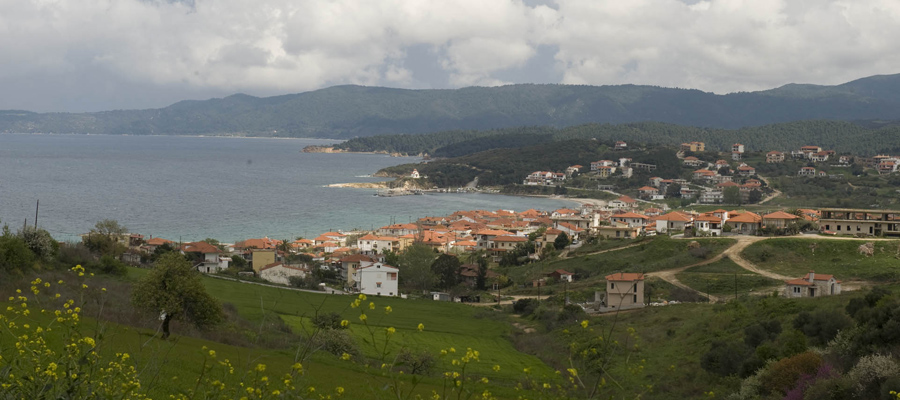Πολλοί χαρακτηρίζουν τα Νέα Ρόδα ως τον μεγαλύτερο οικισμό των προσφύγων που έφτασαν στη βόρεια Χαλκιδική μετά τη Μικρασιατική καταστροφή. Το όνομά του δηλώνει και την καταγωγή των κατοίκων: τα Ρόδα της Προποντίδας. Περίπου 40 οικογένειες αποφάσισαν να εγκατασταθούν, μετά από πολλές περιπλανήσεις, στην θέση «Πρόβλακας» (που σημαίνει πριν από το αυλάκι, δηλαδή πριν από τη Διώρυγα του Ξέρξη) το καλοκαίρι του 1923.
Τα πρώτα εκείνα χρόνια στο στενότερο σημείο της χερσονήσου του Αθωνα οι κάτοικοι των Νέων Ρόδων ασχολήθηκαν κυρίως με τη γεωργία και την αλιεία. Στις μέρες μας χάρη στις υπέροχες παραλίες η περιοχή έχει αναπτυχθεί τουριστικά. Πάνω από 1.200 άνθρωποι μένουν εδώ όλο το χρόνο και, όπως είναι φυσικό, γίνονται πολύ περισσότεροι τους καλοκαιρινούς μήνες. Η μικρή απόσταση από την την Ιερισσό (6 χλμ.) βοηθά στην ταχύτερη ανάπτυξη της περιοχής και οι τουριστικές υποδομές είναι άρτιες.
Οι κάτοικοι ήταν κυρίως θαλασσινοί και έμποροι. Ως ευσεβείς, το πρώτο που πήραν μαζί τους ήταν η θαυματουργή εικόνα της Παναγίας, που σήμερα είναι η προστάτιδα και το καύχημα των Νέων Ρόδων. Ηρθαν, επίσης, οικογένειες από την Ανατολική Θράκη, αλλά και από το Χαράκι και τη Γωνιά της Κυζίκου. Στο μεταξύ ειδοποιήθηκαν οι Ροδιάτες που έμεναν αλλού και οι περισσότεροι, ανταποκρινόμενοι στο κάλεσμα, ήρθαν στα Νέα Ρόδα. Μεσολάβησε η ανταλλαγή των πληθυσμών που ξεκίνησε στις 14 Ιουνίου 1924. Οι τελευταίοι Ελληνες της Μικρασίας ξεριζώθηκαν και μπήκαν στην Ελλάδα αναζητώντας νέα πατρίδα. Μια μεγάλη ομάδα Καππαδοκών έφθασε το 1926 στα Νέα Ρόδα και ο οικισμός πήρε την οριστική του μορφή. Το Ανταβάλ (η Ανταβαλίς, ή Αντίβαλον) της περιφέρειας Νίγδης στην Καππαδοκία ήταν η πατρίδα της ομάδας αυτής. Ηταν χωριό τουρκόφωνο αλλά ελληνικότατο, με περίπου 1,800 κατοίκους. Η εκκλησία του Αγίου Κωνσταντίνου είναι κτίσμα του 500 μ.Χ. και ερείπιά της σώζονται μέχρι σήμερα. Το όνομα του χωριού εκείνου προέρχεται πιθανότατα από το ρήμα «αντιβάλλω» (=εναντιώνομαι), λόγω της διαρκούς αντιδικίας με τους Τούρκους.
Επειδή ο τόπος ήταν βραχώδης, φτωχός και άγονος, με οριακή παραγωγή, οι άντρες έφευγαν για περιοδική εργασία στην Κωνσταντινούπολη. Ειδικά στην περίοδο 1913-1923 υπέφεραν από τούρκικες λεηλασίες και ζούσαν με τον φόβο για τη ζωή τους. Οταν δόθηκε η εντολή της εγκατάλειψης των εστιών, με επικεφαλής τον ιερέα τους Αγαθάγγελο, ξεκίνησαν με τα κάρα τους για Νίγδη-Ουλούγουσλα και κατέβηκαν στη Μερσίνα. Μετά από 1-2 μήνες έφθασαν στον Αϊ Γιώργη του Πειραιά και μετά στη Θεσσαλονίκη. Από εκεί, ένα μεγάλο μέρος πέρασε από τα Πυργαδίκια, την Ουρανούπολη και το Ορφάνι, αλλά η ελονοσία και οι κακουχίες τους έφεραν τελικά στην περιοχή. Για περίπου 5 χρόνια έμεναν στα γύρω μετόχια και στη συνέχεια, με την όποια κρατική βοήθεια, εγκαταστάθηκαν εδώ και έδωσαν στο χωριό τη σημερινή του μορφή.
ΤΟ ΑΡΘΡΟ




